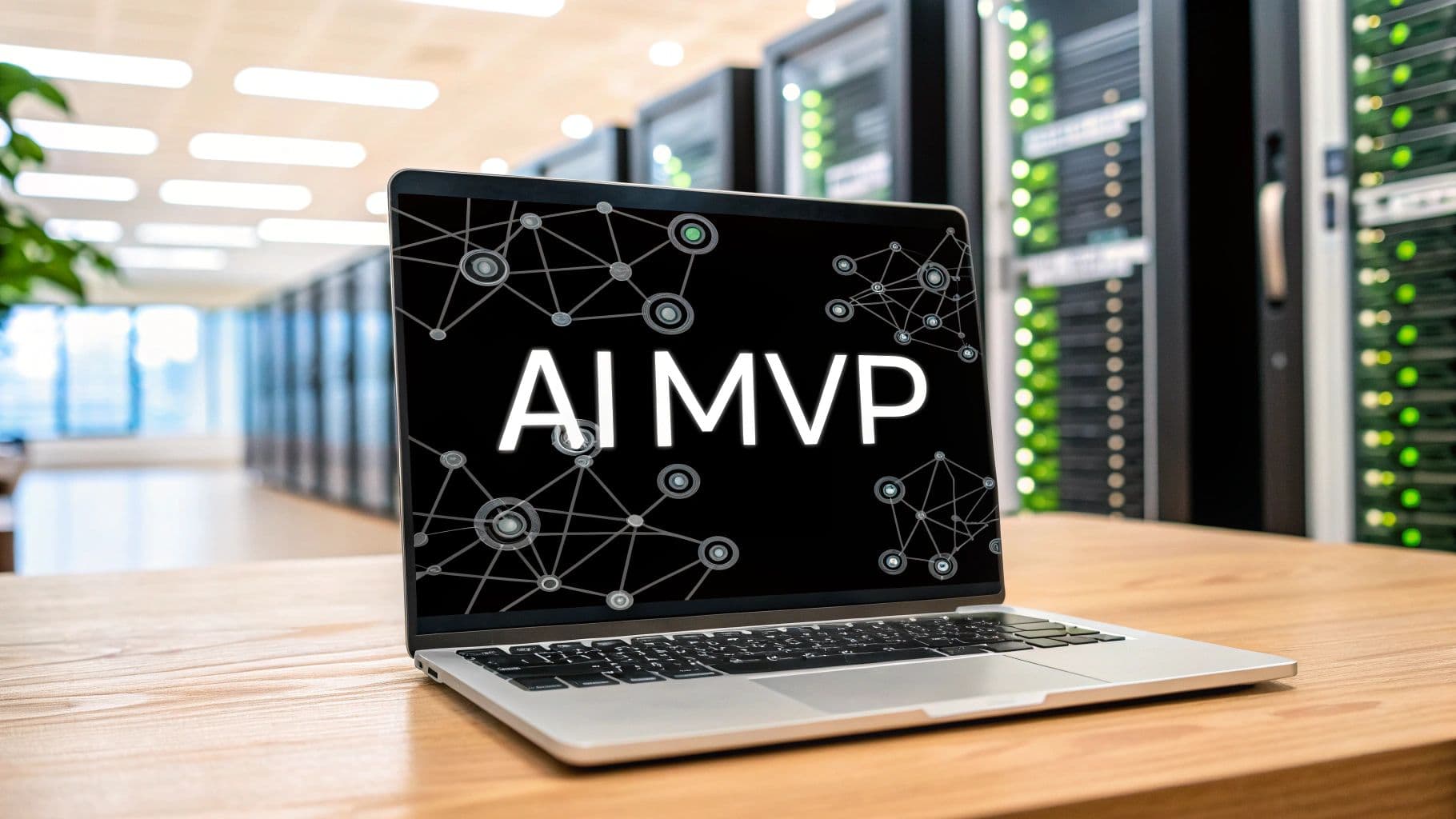developer onboarding
technical onboarding
engineering retention
onboarding framework
developer productivity
Developer Onboarding Process: Tips for Engineering Teams
Why Your Developer Onboarding Process Makes or Breaks Success
A successful developer onboarding process is critical. It's the foundation for a developer's long-term success and, by extension, your team's. A well-structured onboarding experience sets the stage for higher productivity, better code quality, and a stronger team. Conversely, a poorly planned process can lead to frustration, lower efficiency, and even early employee departures. The stakes are high.
The Impact of Effective Onboarding
Imagine a new developer joining your team. A strong onboarding process enables them to understand the project architecture, the team's workflow, and contribute meaningful code within weeks. Without it, they might spend months deciphering documentation, struggling with their development environment, and feeling lost in the codebase. This impacts individual performance and burdens senior developers who must constantly provide support.
Effective onboarding fosters a sense of belonging and empowers new hires to become productive quickly. This directly impacts project timelines and deliverables. A smooth onboarding experience also reduces errors and improves code quality, as new developers learn best practices from the start.
This early investment offers long-term benefits. A strong onboarding process directly correlates with better employee retention. Employees with a positive onboarding experience are 69% more likely to stay with a company for at least three years. This significantly reduces recruitment and training costs. Find more statistics here: Learn more about employee onboarding statistics.
Onboarding as a Competitive Advantage
Attracting and retaining top developer talent is crucial in today's market. A well-designed onboarding process can be a key differentiator, showcasing a commitment to employee growth. It tells potential hires you value their time and are invested in their success from day one.
Common Onboarding Mistakes
Many organizations neglect developer onboarding, relying on informal processes and outdated documentation. This leads to common pitfalls:
-
Lack of Clear Expectations: New developers are unsure of their roles, leading to confusion and reduced productivity.
-
Inadequate Technical Setup: Difficulties with development environment configuration and access management waste time and cause frustration.
-
Insufficient Documentation: Outdated or incomplete documentation hinders understanding of the codebase and effective contribution.
-
Limited Mentorship and Support: Lack of guidance from senior developers can leave new hires feeling isolated.
By addressing these mistakes and investing in a structured, comprehensive developer onboarding process, organizations can significantly improve developer productivity, code quality, and team cohesion. This ultimately drives project success and improves the ability to attract and retain talent. This lays the groundwork for exploring a practical and effective onboarding framework.
Building a Developer Onboarding Framework That Actually Works

Creating an effective developer onboarding process isn't simply about providing logins and a welcome email. It requires a structured framework designed to integrate new developers seamlessly into your team. This section explores the key components of building such a framework, from pre-arrival preparations to technical setup and coding assignments.
Pre-Onboarding Preparation: Setting The Stage For Success
Before a developer's first day, preparing for their arrival is essential. This means pre-configuring their workstation, ensuring accounts are ready, and having documentation prepared. These steps minimize initial hurdles and allow new hires to concentrate on learning and contributing. This creates a positive first impression and establishes a sense of organization from the start.
Technical Environment Setup and Tooling
A consistent and well-documented development environment is essential for productivity. Clear setup instructions or automated scripts can help minimize "it works on my machine" issues. This consistency reduces troubleshooting time, allowing developers to focus on coding, not debugging environmental problems. A well-designed environment also contributes to a positive onboarding experience. Learn how to foster a welcoming environment and improve developer experience.
Access Management and Codebase Orientation
Navigating a new codebase can be overwhelming. Structured access to repositories, clear documentation on code organization, branching strategies, and coding style guidelines are key. Tools like architecture diagrams or interactive code tours can also help accelerate the learning process, allowing developers to explore and understand the codebase with confidence.
Structured Documentation and Mentorship
Comprehensive documentation is a vital resource. However, personal connections are equally important. Pairing new hires with experienced mentors provides guidance and builds a sense of community. Mentorship accelerates technical understanding and integrates developers into the team culture.
Project Assignments and Progressive Coding
Initial coding tasks should be both challenging and achievable. Progressive coding assignments, starting with smaller bug fixes and gradually increasing in complexity, build confidence and provide a sense of accomplishment. These tasks should align with the developer's interests to enhance motivation and engagement, allowing them to contribute meaningful code early on.
The length of onboarding can vary considerably. 52% of new hires report onboarding lasting less than a month—14% for one week and 38% within one month. However, 48% of HR professionals believe it should last at least three months. You can explore this topic further. This highlights the need for a flexible framework adapted to individual and company needs.
The table below illustrates how onboarding components might differ based on company size. It provides a comparison of key elements required for effective onboarding across different organizational structures.
| Onboarding Component | Small Startup | Mid-size Company | Enterprise Organization |
|---|---|---|---|
| Mentorship | Informal, peer-to-peer | Structured program with assigned mentors | Formalized mentorship program with training for mentors |
| Documentation | Wiki-based, evolving | Centralized knowledge base with version control | Comprehensive documentation platform with dedicated team |
| Technical Setup | Guided by senior developer | Standardized scripts and tools | Automated environment provisioning |
As you can see, the level of formality and resources dedicated to each component generally increases with company size. Smaller startups might rely on informal mentorship and evolving documentation, while large enterprises invest in formalized programs and dedicated teams.
A well-structured developer onboarding process is a valuable long-term investment. It allows new hires to become productive faster, leads to improved code quality and fewer errors, and fosters a strong sense of belonging within the team. By following these guidelines and adapting them to your team's structure, you can create an onboarding framework that truly works.
The Right Timeline: How Long Should Developer Onboarding Take?
One of the most common questions tech leaders ask is: how long should developer onboarding actually take? There's no single, perfect answer. The ideal timeline depends on several factors. These include the developer's role and seniority level, the complexity of your codebase, and even whether your team is distributed or co-located. However, by studying successful engineering teams, we can identify some best practices and optimal timeframes.
Phased Approach to Onboarding: Day One, Week One, Month One, and Beyond
Effective developer onboarding should be a phased approach. The first day should concentrate on the essentials: introductions, setting up the workspace, and initial access configurations. The infographic below visualizes a typical first-day orientation flow. It outlines the key stages to prioritize.

As the infographic shows, a structured first day ensures new hires feel welcome and can quickly begin navigating their new environment. This sets a positive tone for the remainder of the onboarding process.
The first week should shift toward understanding the team's workflow, project structure, and development processes. When creating your developer onboarding framework, consider the advantages of tools like Jira and how to automate user management: Automating User Management in Jira. Introduce basic coding tasks to familiarize the developer with the codebase.
The first month builds upon this foundation, allowing for deeper dives into specific projects and more challenging assignments. By the end of the first quarter, the developer should be fully integrated into the team. They should be contributing significantly to projects and comfortable in their role.
To help visualize recommended onboarding timelines, consider the following table:
Recommended Developer Onboarding Timelines
Recommended onboarding durations based on developer seniority and role complexity
| Developer Role | Minimum Duration | Optimal Duration | Key Milestones |
|---|---|---|---|
| Junior Developer | 1 Month | 3 Months | First commit, completion of small bug fixes, participation in code reviews |
| Mid-Level Developer | 2 Weeks | 2 Months | Feature implementation, contribution to design discussions, leading small projects |
| Senior Developer | 1 Week | 1 Month | Architecture design contributions, leading complex projects, mentoring junior developers |
This table outlines recommended durations and highlights key milestones for each level. While these are guidelines, remember to adjust based on individual and project needs.
Tailoring The Timeline: Factors To Consider
While this provides a general framework, adjustments are often necessary. A senior developer joining a team with a well-documented, modular codebase might become productive faster than a junior developer joining a team with a complex, legacy system. A distributed team might require additional communication and virtual collaboration tools during onboarding.
Many companies underinvest in onboarding, despite its importance. The median onboarding duration in the United States is only one week, with 26% of companies using this timeframe, and 25% onboarding in less than a day! Only 11% invest several months. Find more detailed statistics here. This underinvestment can significantly impact developer retention and team performance.
Measuring Onboarding Progress
Regular check-ins and feedback sessions are essential for assessing onboarding effectiveness. These conversations help identify roadblocks and adjust the timeline as needed. They also ensure the developer feels supported. Open communication fosters trust and encourages new hires to actively participate in their onboarding journey. This helps avoid surprises and facilitates faster integration. A well-planned and executed developer onboarding process leads to a more productive, cohesive, and successful team.
From Development Environment To First Commit
The technical onboarding experience for new developers can significantly impact their overall success. A smooth transition from setup to their first code contribution sets the stage for long-term productivity and integration. This section outlines practical steps for environment configuration, tooling, access management, and codebase orientation that contribute to a positive onboarding experience.
Streamlining Development Environment Setup
One of the initial challenges new developers face is setting up their development environment. Inconsistencies between local setups and the production environment can lead to frustrating integration issues. Standardized development environments, however, offer a solution.
Think of it like this: a pre-built, fully equipped kitchen allows a chef to start cooking immediately. They don't have to waste time gathering tools and setting up appliances. Similarly, a pre-configured development environment allows developers to focus on coding, not configuration.
Here are some ways to achieve this:
- Containerization (e.g., Docker): Packaging dependencies and configurations into portable containers ensures consistency across different machines.
- Automated Setup Scripts: Scripts can automate the installation of necessary software, libraries, and dependencies, minimizing manual steps.
- Cloud-Based Development Environments: Cloud platforms offer pre-configured environments accessible via a web browser, eliminating local setup entirely.
Tooling and Access Management: Giving The Right Keys
Beyond the basic development environment, new developers need access to the right tools and resources. This is like giving someone the right keys to navigate a building – they need access to specific areas to do their job effectively.
Consider these essential aspects:
- Version Control System (e.g., Git): Provide clear guidelines on branching strategies, commit conventions, and the team's Git workflow.
- Code Editor/IDE Setup: Recommend or standardize IDEs (Integrated Development Environments) and provide configurations or extensions to enhance productivity.
- Communication Tools: Integrate the new developer into team communication channels like Slack or Microsoft Teams.
- Project Management Tools: Introduce project management software like Jira or Trello for tracking tasks and progress.
Navigating The Codebase: A Guided Tour
A large, unfamiliar codebase can be daunting. Imagine exploring a new city – a guided tour is far more helpful than just having a map. Similarly, a structured approach to codebase orientation significantly improves a new developer's understanding.
Effective strategies include:
- Codebase Overview: Provide documentation or presentations that explain the overall architecture, key modules, and coding conventions.
- Architecture Visualization Tools: Tools that visually represent the codebase structure can help developers grasp the relationships between different components.
- Guided Code Walkthroughs: Senior developers can walk new hires through critical code sections, explaining key design decisions and functionality.
- "Good First Issues": Assign small, well-defined tasks for quick contributions and confidence-building.

First Commits and Code Reviews: Building Momentum
The first code contributions are a critical part of the onboarding process. Structure these initial tasks to ensure success and positive reinforcement.
Consider these approaches:
- Pair Programming: Working with a senior developer provides guidance and real-time feedback.
- Code Shadowing: Observing experienced developers on real projects offers valuable insights into workflows and coding practices.
- Structured Code Reviews: Thorough code reviews with constructive feedback help new developers learn best practices and improve code quality.
By implementing these strategies, you can create a technical onboarding experience that empowers new developers. This enables them to become productive quickly, contribute meaningfully, and integrate smoothly into the team. This approach fosters a positive and supportive engineering culture, setting the stage for both individual and team success.
Finding the Sweet Spot: Documentation vs. Human Connection

Successfully onboarding new developers requires a careful balance. It's about combining thorough documentation with genuine human interaction. This section explores how successful engineering organizations achieve this balance, creating an onboarding experience that informs and welcomes new team members.
Creating and Maintaining Quality Onboarding Materials
Documentation is the foundation of any effective developer onboarding process. Keeping it updated, especially with constantly changing codebases, can be difficult. This is where living documentation becomes essential.
Living documentation is constantly evolving and connected to the development process. It's a continuously updated guide that accurately reflects the current code. Tools like automated documentation generators, such as Swagger or JSDoc, can synchronize documentation with code changes, preventing it from becoming outdated.
Interactive tutorials are another important element. These tutorials provide hands-on learning, guiding new developers through the codebase and its functions. They're particularly useful for more complicated systems.
Self-service resources, like FAQs and troubleshooting guides, empower developers to find answers independently. This frees up senior developers to focus on more demanding tasks.
The Human Element: Mentorship and Team Integration
While good documentation is essential, personal connection is equally important. Mentorship programs and buddy systems offer new hires personalized guidance and support.
Mentorship programs pair experienced team members with new developers. Mentors share insights into company culture, best practices, and codebase specifics. This personalized support can significantly accelerate learning and integration.
Buddy systems create a more informal support network. A "buddy" is a go-to person for quick questions and practical advice, smoothing the transition into the new team.
These interactions cultivate psychological safety. Developers feel comfortable asking questions and seeking assistance. This is crucial for a collaborative and supportive team environment.
Structured Interactions and Social Integration
Beyond mentors and buddies, structured interactions further improve onboarding. Regular meetings between managers and new hires create opportunities for feedback and open discussion. These check-ins help address any concerns and keep the developer's progress on track.
Coding dojos create collaborative learning environments. Developers work together on coding exercises, sharing knowledge and building team cohesion. These sessions build skills and team spirit.
Social events, such as team lunches or outings, help new hires connect with their colleagues informally. This builds camaraderie and belonging within the team.
By combining comprehensive documentation with meaningful human connection, teams build an effective onboarding process. This approach reduces the initial learning curve, boosts productivity, and creates a supportive team environment. This approach sets new developers up for success and contributes to a strong engineering culture.
Measuring What Matters: KPIs for Developer Onboarding Success
How do you know if your developer onboarding process is truly effective? This section explores the key performance indicators (KPIs) that offer genuine insights into your program's success. We'll look at both the hard data from quantitative KPIs and the valuable perspectives provided by qualitative feedback. This combined approach gives you a complete and nuanced understanding of your onboarding effectiveness.
Quantitative KPIs: Measuring Tangible Progress
Quantitative KPIs offer the concrete data points that track a new developer’s journey. These metrics provide tangible evidence of how well your onboarding program is working.
-
Time to First Commit: This measures how long it takes a new developer to make their initial code contribution. A shorter time often suggests a more streamlined onboarding experience and faster integration into the team’s workflow.
-
Code Quality Indicators: Tracking metrics such as code complexity, defect rate, and adherence to style guides can reveal a lot about the quality of a new developer's code. Improvements over time showcase the impact of your onboarding efforts in fostering best practices.
-
Ramp-Up Period: This metric gauges the time it takes for a new developer to become fully productive. A shorter ramp-up period is a clear indication of successful onboarding.
Qualitative KPIs: Understanding The Human Element
Numbers tell a story, but qualitative feedback provides the human context. These insights often uncover the less obvious, yet equally important, aspects of the onboarding experience.
-
Confidence Levels: How confident do new developers feel in their abilities? This subjective measure can be a powerful indicator of their progress. Regular check-ins and surveys can help you understand their comfort levels.
-
Team Integration: Observing a new developer's integration into the team dynamic offers valuable insights into their sense of belonging. Team feedback and observation of interactions can help assess this critical aspect of onboarding.
-
Knowledge Retention: Effective onboarding ensures developers retain what they learn. Quizzes, practical exercises, and code reviews can offer insights into how well new developers are absorbing information.
Gathering Actionable Feedback: Beyond Feel-Good Surveys
Feedback should offer more than just general opinions; it needs to provide actionable insights. This means structuring your feedback mechanisms to pinpoint specific areas for improvement.
-
Structured Feedback Forms: Instead of generic questions, use specific inquiries related to the different stages of onboarding. For instance, ask about the clarity of documentation or the helpfulness of the mentorship program.
-
Regular Check-Ins with Mentors: Frequent discussions with mentors can reveal a new developer’s progress and any challenges they are encountering. These personal conversations offer tailored feedback and identify areas where additional support might be needed.
-
Post-Onboarding Interviews: Conducting interviews after the initial onboarding period allows for valuable reflection on the entire process. This retrospective feedback can uncover hidden pain points and opportunities for refinement.
Continuous Improvement: Using Data to Refine Your Process
Successful engineering organizations leverage data from these KPIs to continuously improve their onboarding processes. By regularly reviewing these metrics and feedback, you can identify areas of friction, update outdated materials, and customize your approach to meet individual needs.
This data-driven approach to onboarding not only improves the developer experience but also demonstrates the return on investment of your efforts. It’s about making informed decisions and constantly striving for a more efficient and effective onboarding process.
Boost your team's productivity and launch AI-powered projects faster with AnotherWrapper. This comprehensive AI toolkit empowers developers to build and deploy innovative applications quickly. Explore AnotherWrapper today and see how it can transform your development workflow.
Fekri




